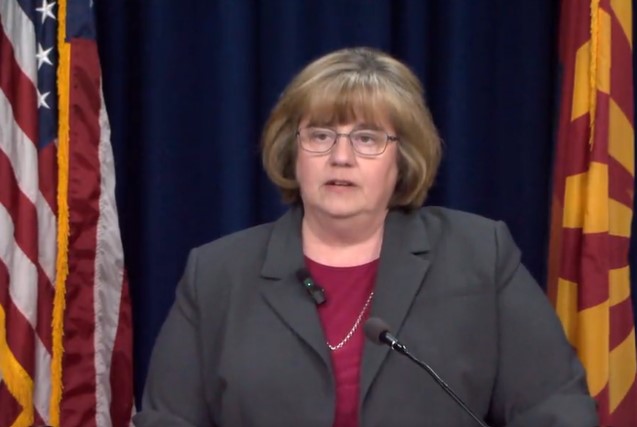
by Corinne Murdock | Jul 2, 2023 | News
By Corinne Murdock |
The city of Phoenix sought advice on handling homelessness from another city plagued by the same problem: Portland, Oregon.
City officials attended a “homelessness summit” in May. Officials included Gina Montes, deputy city manager; Rachel Milne, director of the Office of Homeless Solutions (OHS); Scott Hall, deputy director of OHS; Titus Mathew, director of the city’s housing department; Sean Connolly, assistant chief of operations for Phoenix Police Department (PPD); Brian Fruendentahl, commander of PPD; Luke Christian, assistant city attorney.
“Given our issues and the continued increase in unsheltered homelessness, the crime and other complex problems, we have been in touch with other communities to see what we can learn (both from their successes and mistakes),” wrote Montes in an invitation email for the event.
Officials from the cities of Mesa and Glendale were invited on the trip, but it appears from records obtained by AZ Free News that a visit to Portland either didn’t sound appealing or beneficial. In a March email exchange, the city of Mesa’s deputy city manager, Natalie Lewis, asked why Montes and the city of Phoenix felt the need to go to Portland as well as Seattle, Washington — another proposed location for a homelessness summit.
Glendale’s director of community services, Jean Moreno, concurred with Lewis’ remarks.
“Our feedback was the same as Mesa’s — happy to participate but not sure Portland is the right field trip,” wrote Moreno.
Montes responded that Phoenix could learn much from Portland’s mistakes. She revealed that many of the issues facing Phoenix currently were the same as those Portland faced in the past. Meaning: Portland could be Phoenix’s future, if changes aren’t made.
“The reason we are interested in Portland is honestly because a lot of the same issues are happening here that happened there years ago. They made a lot of mistakes that they are paying for now. I’m concerned that our community trajectory is pointing in a similar direction,” wrote Montes. “I understand if Portland is not of interest to others and promise not to be offended!”
The homeless in Portland have taken over residential neighborhoods and public streets, with residents telling reporters that the crime-riddled mass encampments decimated quality of life.
Lewis turned down the invitation, sharing that she may attend a potential future trip to either San Antonio or Houston, Texas, potentially around the same time as this fall’s ICMA Conference in Austin, Texas. Lewis added that the breakup of the mass homeless encampment known as The Zone would likely impact her city.
“Also, I foresee the work to dismantle/relocate will impact Mesa. I am open to having a regional discussion on this (when Phx is ready) so that we are all working to minimize impact of the shift,” wrote Lewis.
Montes issued the proposal to visit either Portland or Seattle on March 29: two days after the Maricopa County Superior Court ordered the city to clean up The Zone.
Estimates of the homeless population in the Portland area hovers around 5,000, based on Multnomah County data. Phoenix’s homeless population sits around 3,000.
AZ Free News asked Montes whether city officials would attend similar summits in other cities who’ve mitigated homelessness in recent years such as Austin, Texas. Montes didn’t respond by press time.
City of Phoenix officials were also joined by officials from the Maricopa Association of Governments (MAG), Maricopa County, and the city of Avondale. MAG representatives were Continuum of Care officials Amy St. Peter, deputy executive director, and Katy Gentry, regional homelessness program manager. Maricopa County officials were Jacqueline Edwards, human services director, and T.J. Reed, homelessness programs manager. City of Avondale representatives were Cherlene Penilla, assistant city manager; Dale Nannenga, chief of the Office of Public Safety; Memo Espinoza, chief of Avondale Police; Manuel Rios, sergeant of Avondale Police; and Brian Planty, homeless services manager.
The cost for the trip, for all 16 officials in attendance, likely totaled around $10,000. (Based on averages of flight, hotel, and per diem costs compiled from MAG travel request forms).
Corinne Murdock is a reporter for AZ Free News. Follow her latest on Twitter, or email tips to corinne@azfreenews.com.

by Corinne Murdock | Jul 2, 2023 | Education, News
By Corinne Murdock |
On Thursday, the Ninth District Circuit Court denied Superintendent Tom Horne’s emergency petition for the relocation of a lawsuit challenging Arizona’s ban on boys in girls’ K-12 sports.
Horne filed the emergency petition last month after District Court Judge Jennifer Zipps twice refused to approve his requested change of venue to a Phoenix court. The case sits currently in Tucson.
Horne’s team argued in their change of venue requests that his residency and primary duties as superintendent relegated him to Phoenix, making travel to a Tucson hearing difficult to arrange. They also argued that Zipps failed to follow Ninth Circuit precedent deferring to the state’s strong public policy interest in protecting residents and elected officials subject to frequent lawsuits from inconvenient venues.
“The District Court thus seriously erred and abused its discretion in overlooking or failing to properly weigh the effect of two Arizona statutes requiring suits against public officials to be filed in the county in which they hold office […] and requiring suits against the state to be filed in Maricopa County,” stated Horne. “Because public officials are subject to more lawsuits based on their public service, the State of Arizona has enacted special venue provisions requiring that public officials be sued in a venue that is convenient to the public official[.]”
However, the Ninth District Court determined that Horne hadn’t demonstrated a “clear and indisputable right” to such a change of venue.
In the case, Jane Doe v. Thomas Horne, the parents of an 11-year-old boy and a 15-year-old boy sued the state in April. The parents are seeking an injunction on SB1165, which requires children to play on sports teams aligning with their gender in K-12 sports.
The lawsuit claims that transgenderism — a mental dissonance between one’s perceived and actual biological gender — is a sex-based trait.
The lawsuit also claimed that all individuals have a gender identity — a perception of one’s gender in addition to their biological reality — and that the only proper treatment for those with gender dysphoria was to allow the full exercise of the dysphoric feelings.
The children in the case are an 11-year-old Maricopa County boy that desires to play girls’ basketball, cross country, and soccer, named “Jane Doe” for anonymity, and a 15-year-old Pima County boy who desires to play girls’ volleyball, “Megan Roe.”
“Under the medical standards of care for the treatment of gender dysphoria in adolescents, the only safe and effective treatment for gender dysphoria is to permit transgender adolescents to live consistent with their gender identity in all aspects of their lives,” stated the lawsuit.
Doe hasn’t begun puberty blockers yet, but plans to at the onset of puberty; Roe has been on puberty blockers since 11 years old, and hormone replacement therapy since 12 years old.
Horne told The Associated Press that the lawsuit was “backwards” and an attempt to steal protections instituted for girls and women originally.
“Title IX was aimed at giving girls equal opportunities for playing sports. When a biological boy plays in a girl’s sport, it disadvantages the girls,” said Horne. “There have been lots of news stories about girls who worked hard to excel at their sports, found they could not when they had to compete against biological boys and were devastated by that.”
One mother, who remains anonymous due to concerns over her family’s safety, told The Associated Press that she worries about her son’s mental health due to this lawsuit.
“Jane knows this would be because [he] is transgender, and I worry about how that will affect [his] self-esteem and [his] confidence,” said the mother.
AIA first began to allow transgender students to compete on the sports team of the opposite sex in 2014. The AIA thereafter considered these acceptances on a case-by-case basis. In 2018, the AIA revised the policy to allow students to compete on sports teams that aligned with their gender identity rather than biological sex.
The lawsuit claimed that since no reported harm had come of the several students who exercised this policy, the Arizona legislature had no basis for passing its ban last year.
Attorney General Kris Mayes refused to defend the law in court, prompting State Sen. President Warren Petersen (R-LD14) and State House Speaker Ben Toma (R-LD27) to intervene.
Corinne Murdock is a reporter for AZ Free News. Follow her latest on Twitter, or email tips to corinne@azfreenews.com.

by Corinne Murdock | Jul 1, 2023 | Education, News
By Corinne Murdock |
Every year, Cox Communications gives tens of thousands to minority students through its diversity scholarships.
This year, the broadband, cable, and telecommunications company issued $35,000 to 10 students. Each student received $3,500. Cox Communications began offering the diversity scholarships in 2014.
Eligible students can’t be white; they must maintain a minimum 2.5 GPA.
Partners to the scholarship fund include YWCA Metro Phoenix, ACEL, Be a Leader Foundation, NAACP Maricopa Branch, One n Ten, Sunnyside Educational Foundation, Women’s Foundation for the State of Arizona, Greater Phoenix Urban League, Valle Del Sol, and the Educational Enrichment Foundation.
In a statement related to this year’s scholarship offering, Cox vice president of communications, Susan Anable, said that diversity of race correlates directly to stronger communities.
“Ensuring that diverse students have access to higher education will create stronger communities throughout Arizona,” said Anable. “We know that the cost of college can be prohibitive, and the challenge can be stressful for students and their families. We’re proud to connect families to opportunities like this one.”
In a statement regarding the awardees, Anable clarified that these scholarships were part of their company’s commitment to diversity, equity, and inclusion (DEI).
“These annual Cox Diversity Scholarships are how we demonstrate our commitment to fostering diversity, equity and inclusion both within our company and in the communities we serve,” said Anable.
Cox Communication’s DEI initiatives include equitable promotion tracks to match the diversity of surrounding communities and customers. The company also established seven DEI councils across the states and regions it serves: California, Southwest, Central, Southeast, Northeast, Virginia, and Atlanta.
In addition to diversity scholarships, Cox Communications also implements race and identity-based diversity standards for its supply chain partnerships. The company identifies nine different race or identity classifications for diverse suppliers: minorities, women, LGBTQ+, disability, veterans, disabled veterans, and service-disabled veterans. In order to qualify for business with Cox Communications, those businesses must be at least 51 percent owned, operated, or controlled by a diverse group listed.
“We make it a priority to work with diverse-owned businesses and will continue to invest in the inspired talent and innovation diverse suppliers have to offer,” said George Richter, Cox’s senior vice president of supply chain management.
Even those diversity-led businesses who don’t qualify for supply chain partnership may still benefit from Cox Communications DEI commitment. The company offers a scholarship program for diverse-owned businesses through Arizona State University Thunderbird School of Global Management, UNLV Lee Business School, Council for Supplier Diversity, Delgado Community College, and Old Dominion University.
For their DEI efforts, Cox Communications has won multiple awards from DiversityInc over the last two years, as well as numerous diversity awards from Forbes.
Corinne Murdock is a reporter for AZ Free News. Follow her latest on Twitter, or email tips to corinne@azfreenews.com.

by Daniel Stefanski | Jul 1, 2023 | Economy, News
By Daniel Stefanski |
One of Arizona’s freshmen Republican representatives is pleased after his bill survived the Governor’s Office.
On Tuesday, Representative Michael Carbone announced that HB 2809, which he sponsored had been signed into law by Democrat Governor Katie Hobbs.
According to Carbone, HB 2809 “helps communities build public improvements to attract manufacturing investment by doubling the lifetime cap of construction tax dollars that a city, town, or county can get back from the state.”
In a statement, Representative Carbone said, “Arizona is on the leading edge of advanced manufacturing – an industry that’s investing billions, and creating thousands of high-paying, skilled jobs for what I call a ‘new blue-collar workforce.’ HB 2809 makes it possible for the state to provide communities more help to build the critical business infrastructure improvements they’ll need to attract advanced manufacturing investment. Infrastructure serves as the backbone of a state, and I believe that broad based, industry neutral incentives which support public infrastructure are a proper role of government and will ensure that Arizona will continue to be a reliable partner. This was a great first bill to have signed into law, and it’s the kind of policy that I came to the legislature to advance to move Arizona forward.”
Earlier in June, the Arizona Chamber of Commerce and Industry supported the passage of this proposal through the state legislature, tweeting, “PASSED! The #AZLeg on a bipartisan vote just approved HB 2809, the business community’s priority bill of this legislative session. With this vote, Arizona is one step closer to solidifying our reputation as the No. 1 state for manufacturing growth. HB 2809 is a critical economic development tool that will improve local infrastructure & ensure AZ remains a attractive place for manufacturers to invest. We’re grateful to lawmakers – especially sponsor Michael Carbone – for supporting this bill & sending it to the governor’s desk.”
In Carbone’s release, he explained, “State law provides that a city, town or county may be paid up to 80% of the cost of public infrastructure improvements for the benefit of a manufacturing facility and that the funds distributed are from tax revenues received from persons conducting business under the Prime Contracting Classification derived from contracts to construct buildings and associated improvements for the benefit of a manufacturing facility. HB 2809 raised the total amount paid to all cities, towns and counties that can be paid by the state, from $100 million to $200 million.”
Representatives from the City of Chandler, Intel Corporation, Queen Creek Chamber of Commerce, Taiwan Semiconductor Manufacturing Company, Greater Phoenix Leadership,
Southern Arizona Leadership Council, and the City of Phoenix endorsed the bill throughout the legislative process.
Daniel Stefanski is a reporter for AZ Free News. You can send him news tips using this link.

by Daniel Stefanski | Jun 30, 2023 | News
By Daniel Stefanski |
Arizona elected officials continue to react to Democrat Governor Katie Hobbs’ recent Executive Orders.
Earlier this week, Governor Hobbs signed two Executive Orders to “restore rights and protect LGBTQ+ Arizonans.” According to Hobbs’ Office, the Orders “ensure the state employee health care plan covers medically-necessary gender-affirming surgery” and bar “state agencies from funding, promoting, or supporting conversion therapy against LGBTQ+ Arizonans.”
Hobbs’ most-recent Executive Orders came just days after she signed another Order that would “centralize all abortion-related prosecutions under the Attorney General to ensure differences in applications of the law by county attorneys do not restrict access to legal abortions.”
On Wednesday, Senate President Pro Tempore T.J. Shope issued the following statement regarding the governor’s latest Orders: “Instead of helping families struggling to keep a roof over their heads, fill their tanks with gas and put food on the table, Governor Hobbs is making sure taxpayer dollars are instead going towards elective, sex change surgeries. The Governor continues to show just how tone deaf and out of touch she is with the majority of hard-working Arizonans. Director nominations hearings were suspended on Monday, and yet the Governor is already doubling down with another unilateral overreach. The Arizona Senate Majority Caucus is committed to checks and balances and will be reviewing all legal options to ensure appropriate constitutional separation of powers.”
Representative John Gillette took to Twitter to pose several questions to the state’s chief executive, writing, “Hobbs Signs EO to Allow State Employees to Have Sex Change procedures paid by State Health Insurance. 1. What happens to premiums? 2. Was the contract renegotiated? 3. What other elected surgery will get covered? Will BC/BS just cancel the contract as terms changed?
Maricopa County Attorney Rachel Mitchell also responded to the governor’s order on abortion prosecutions, saying, “Our current governor took an entire category of potential offenses and is attempting to prevent locally elected county attorneys from reviewing and making charging decisions on those matters. But what happens next? What happens in three-and-a-half years? What happens when another person occupies the governor’s seat and attempts this kind of power grab? What other set of offenses might a governor in the future not like and remove from local prosecutors?”
Daniel Stefanski is a reporter for AZ Free News. You can send him news tips using this link.

by Corinne Murdock | Jun 30, 2023 | News
By Corinne Murdock |
The city of Phoenix is being sued over its capitalization of a loophole to shield high-rise luxury apartments from up to an estimated $7 million in property taxes.
The city of Phoenix effectively agreed to relieve private real estate developer Hubbard Street Group of around $7 million in property taxes by taking ownership of their property, “Skye on 6th,” and declaring it part of a slum or blighted area while the developer continues to operate and manage the property. In return, the developer agreed to pay a total of $525,000 in rent to the city, pay $32,000 to two school districts, and dedicate 10 percent of its residential units to workforce housing for the eight years of the lease. The city arranged this deal through the state’s statutory provisions outlining the Government Property Lease Excise Tax (GPLET).
In the case Paulin v. City of Phoenix, two taxpayers represented by the Goldwater Institute sued the city over allegedly violating the Arizona Constitution’s Gift Clause and Evasion Clause.
Since local governments are exempt from property taxes, GPLET enables governments to accrue revenue on its property by leasing to businesses. The Goldwater Institute, on behalf of the two Phoenix taxpayers, argues that the city took advantage of GPLET by assuming ownership of the property of interest to a private business in order to provide a special tax break to that business. Although the government sustains a reduced revenue stream and taxpayers pay more under such an arrangement, the Goldwater Institute alleges that local politicians may claim business growth while paying off the business with a tax write-off.
“[U]nder this arrangement, private property is conveyed in form to the government while in substance being owned and operated by a private party for the sole purpose of evading property taxes to which other taxpayers are subject,” stated the complaint. “The result of this arrangement is a gift of public resources to a private business, and a conveyance of property to evade taxes in violation of Arizona’s Constitution.”
Those poised to lose out on their share of the $7 million in tax payments would include the city, Maricopa County, Maricopa County Community College District, Central Arizona Project, Maricopa Special Healthcare District, Fire District Assistance Tax, and special taxing districts for library and flood control. Phoenix Elementary School District and Phoenix Union High School District are the two school districts receiving the tens of thousands to reportedly offset their share of the lost tax revenue.
The Goldwater Institute also disputed the city’s characterization of the contested property as located in a slum or blighted area: a condition required for an eight-year tax abatement as provided in the GPLET agreement between Phoenix and the developer.
A hearing on the case took place last week in the Maricopa County Superior Court. The city argued that taxpayers upset by their arrangement with the developer were truly upset with the existence of GPLET. The city contended that the taxpayers should petition lawmakers to reform GPLET law to prevent their actions.
Counsel for the city also contended that any claims that their actions violated the Gift Clause would render GPLET impossible to use.
The city also claimed that Hubbard Street Group was chosen through the request-for-proposal (RFP) process, and disputed the claim that Hubbard Street Group approached the city first.
The Goldwater Institute argued that there were no actual reservations of ownership, control, or management of the property. They also argued that the city never intended to hold onto the property itself, but always intended to convey the property back to the lessee. Counsel for the developer contended that claim, referencing a contract provision that the property will be owned by the city.
In a statement, Goldwater Vice President for Litigation Jon Riches said that Phoenix’s use of GPLET is unconstitutional.
“The Arizona Constitution prohibits the transfer of property to evade taxes that are otherwise owed and that other taxpayers must pay,” said Riches. “Here, the city of Phoenix allowed private property to be transferred to the city even though it will never be used as city property so that one special interest could avoid paying taxes on it. We are hopeful the court will agree this artificial transfer violates the Constitution.”
In 2020, the Maricopa County Superior Court struck down a similar GPLET arrangement between the city of Phoenix and another high-rise residential developer. Four months later, the city entered into the currently-contested GPLET agreement with Hubbard Street Group.
A ruling on the case may occur sometime within the next several months.
Corinne Murdock is a reporter for AZ Free News. Follow her latest on Twitter, or email tips to corinne@azfreenews.com.






